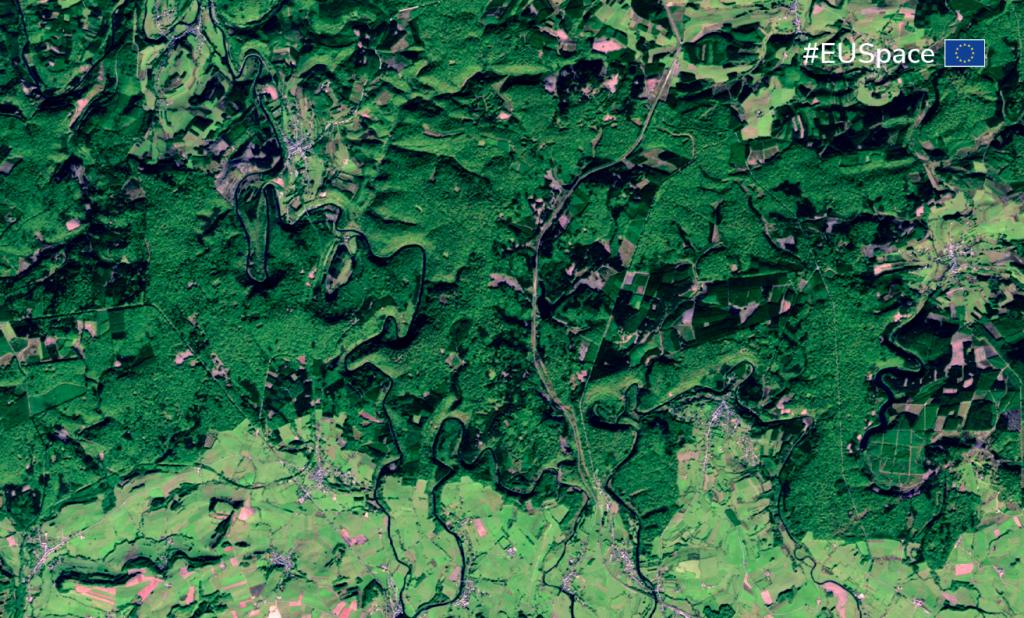Copernicus takes centre stage in the EU’s fight against deforestation

Forests are a resource that keep on giving. Not only do they provide shade on a hot sunny day, forests are also home to a wide range of flora and fauna. Furthermore, trees are a crucial raw material for a range of everyday products, including the packages made by the pulp and paper industry. And who of us hasn’t enjoyed a walk in the woods?
But today trees play another important role: that of climate ally.
Capable of absorbing and storing vast amounts of CO2, forests are our secret weapon in the fight against climate change. According to some estimates, trees can remove up to 328 million tonnes of CO2 from atmosphere per year. This CO2 is then stored, with the Forest Information System for Europe calculating that, as of 2020, forests hold a total carbon stock of 92.1 gigatonnes.
Unfortunately, tree cover loss continues to accelerate – by as much as 4.7 million hectares a year! This is the result of human activity, climate change, forest fires, extreme weather events and disease.
But all is not lost. By leveraging Earth Observation (EO) data, including that coming from the Copernicus programme, we have a real shot at protecting and even restoring our critical forests.
EO helps EU Forest Strategy ‘grow the sink’
The recent Copernicus for Forestry workshop co-organised by EUSPA and the European Commission put the spotlight how Earth Observation and Copernicus, benefits the forestry sector. “Earth Observation allows for the remote monitoring and health assessment of forest inventories, as well as the detection of such issues as deforestation,” said Fiammetta Diani, Head of the Market Development and Innovation department.
The event, which welcomed over 400 online attendees and featured 70 experts from both the public and private sectors, preceded the International Day of Forests, celebrated annually on 21 March. The workshop was also aligned with developments in such forestry-related regulations as the EU Forest Strategy for 2030, the EU Deforestation-Free Products Regulation and the proposed Forest Monitoring Law.
“With the goal of ‘growing the sink’, the EU Forest Strategy aims to improve the quantity and quality of Europe’s forests while also strengthening their protection, restoration and resilience – all of which will require information and data coming from Earth Observation,” explained Chiara Solimini, EUSPA.
According to the latest edition of EUSPA’s EO and GNSS Market Report, the integration of EO data, coupled with Artificial Intelligence and advanced big data analytics and leveraging the capabilities of cloud computing, introduces objectivity and transparency to the evaluation of the strategy's effectiveness.
Earth Observation at the heart of the Deforestation-Free Products Regulation
The Deforestation-Free Products Regulation (EUDR) is a ground-breaking law aimed at combatting global deforestation. This regulation, which passed in 2023, establishes mandatory due diligence requirements for all operators and traders involved in the import, distribution or export of various commodities within the EU market, including soy, beef, palm oil, cocoa, coffee, rubber and timber, along with derived products such as furniture and printed paper. It requires anyone who place commodities on the EU market, or export from it, to demonstrate that the plot where the commodity was produced does not contribute to deforestation.
One of the best ways of doing this is with Earth Observation.
The Copernicus Land Monitoring Service (CLMS) and the new EU Observatory on deforestation and forest degradation are already developing EO-based tools for forest monitoring. Using Copernicus and the optical and radar instruments onboard Sentinel satellites, these tools can provide forestry stakeholders global data with a high acquisition frequency – all free of charge.
Private companies also play a critical role in monitoring deforestation and supporting operators and traders impacted by EUDR. During the workshop, companies such as Airbus, Satelligence, LiveEO and innovative start-ups including Orbify, Beetle for Tech and KERMAP, showcased their cutting-edge, end-to-end space-based solutions for detecting, mapping and monitoring deforestation.
To enforce the EUDR, EU authorities will use company-provided information such as GNSS-enabled coordinates of land plots where commodities are produced, EO-based deforestation analysis or complementary data (e.g., geotagged photographs). They will also conduct thorough inspections utilising satellite monitoring tools and in-situ analysis, ensuring that the commodities in question do not originate from deforested areas.
“While the regulation does not specifically require the use of Copernicus, there is a huge potential for Member States to leverage Copernicus data and services to support activities related to the required checks on imported and exported commodities,” noted Solimini.
Proposed Forest Monitoring Law to mandate use of space data
Another topic of discussion was the proposed Forest Monitoring Law, which aims to plug existing gaps in the information on European forests. To do this, the proposal looks to create a comprehensive forest knowledge base that Member States, forest owners and forest managers can all use to improve their response to the growing pressures on forests and strengthen forest resilience.
But what makes the proposal really unique is that it is the first draft EU legislation that specifically mandates the use of space data for environmental monitoring.
“This is yet another example of how EU Space is becoming a key enabling tool for forestry managers to efficiently execute forestry operations and for governmental bodies to monitor the environmental impact of forestry activities,” concluded Diani.
To learn more about how EU Space benefits the forestry sector, download your free copy of the new GNSS and EO Market Report.
Media note: This feature can be republished without charge provided the European Union Agency for the Space Programme (EUSPA) is acknowledged as the source at the top or the bottom of the story. You must request permission before you use any of the photographs on the site. If you republish, we would be grateful if you could link back to the EUSPA website (http://www.euspa.europa.eu).